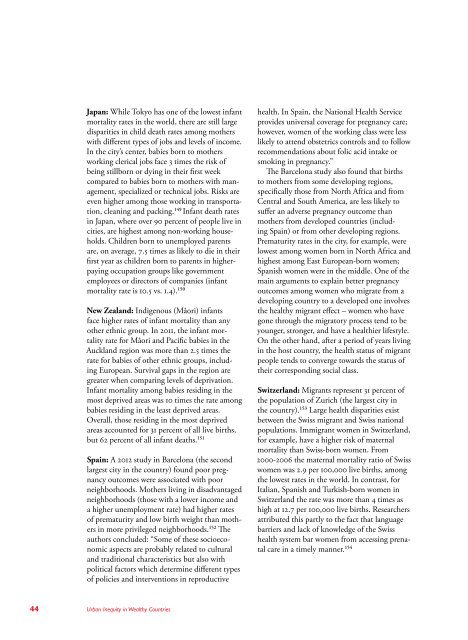sowm_2015__int__africa_full_report_low_res
sowm_2015__int__africa_full_report_low_res
sowm_2015__int__africa_full_report_low_res
You also want an ePaper? Increase the reach of your titles
YUMPU automatically turns print PDFs into web optimized ePapers that Google loves.
Japan: While Tokyo has one of the <strong>low</strong>est infant<br />
mortality rates in the world, there are still large<br />
disparities in child death rates among mothers<br />
with different types of jobs and levels of income.<br />
In the city’s center, babies born to mothers<br />
working clerical jobs face 3 times the risk of<br />
being stillborn or dying in their first week<br />
compared to babies born to mothers with management,<br />
specialized or technical jobs. Risks are<br />
even higher among those working in transportation,<br />
cleaning and packing. 149 Infant death rates<br />
in Japan, where over 90 percent of people live in<br />
cities, are highest among non-working households.<br />
Children born to unemployed parents<br />
are, on average, 7.5 times as likely to die in their<br />
first year as children born to parents in higherpaying<br />
occupation groups like government<br />
employees or directors of companies (infant<br />
mortality rate is 10.5 vs. 1.4). 150<br />
New Zealand: Indigenous (Mâori) infants<br />
face higher rates of infant mortality than any<br />
other ethnic group. In 2011, the infant mortality<br />
rate for Mâori and Pacific babies in the<br />
Auckland region was more than 2.5 times the<br />
rate for babies of other ethnic groups, including<br />
European. Survival gaps in the region are<br />
greater when comparing levels of deprivation.<br />
Infant mortality among babies <strong>res</strong>iding in the<br />
most deprived areas was 10 times the rate among<br />
babies <strong>res</strong>iding in the least deprived areas.<br />
Overall, those <strong>res</strong>iding in the most deprived<br />
areas accounted for 31 percent of all live births,<br />
but 62 percent of all infant deaths. 151<br />
Spain: A 2012 study in Barcelona (the second<br />
largest city in the country) found poor pregnancy<br />
outcomes were associated with poor<br />
neighborhoods. Mothers living in disadvantaged<br />
neighborhoods (those with a <strong>low</strong>er income and<br />
a higher unemployment rate) had higher rates<br />
of prematurity and <strong>low</strong> birth weight than mothers<br />
in more privileged neighborhoods. 152 The<br />
authors concluded: “Some of these socioeconomic<br />
aspects are probably related to cultural<br />
and traditional characteristics but also with<br />
political factors which determine different types<br />
of policies and <strong>int</strong>erventions in reproductive<br />
health. In Spain, the National Health Service<br />
provides universal coverage for pregnancy care;<br />
however, women of the working class were less<br />
likely to attend obstetrics controls and to fol<strong>low</strong><br />
recommendations about folic acid <strong>int</strong>ake or<br />
smoking in pregnancy.”<br />
The Barcelona study also found that births<br />
to mothers from some developing regions,<br />
specifically those from North Africa and from<br />
Central and South America, are less likely to<br />
suffer an adverse pregnancy outcome than<br />
mothers from developed countries (including<br />
Spain) or from other developing regions.<br />
Prematurity rates in the city, for example, were<br />
<strong>low</strong>est among women born in North Africa and<br />
highest among East European-born women;<br />
Spanish women were in the middle. One of the<br />
main arguments to explain better pregnancy<br />
outcomes among women who migrate from a<br />
developing country to a developed one involves<br />
the healthy migrant effect – women who have<br />
gone through the migratory process tend to be<br />
younger, stronger, and have a healthier lifestyle.<br />
On the other hand, after a period of years living<br />
in the host country, the health status of migrant<br />
people tends to converge towards the status of<br />
their cor<strong>res</strong>ponding social class.<br />
Switzerland: Migrants rep<strong>res</strong>ent 31 percent of<br />
the population of Zurich (the largest city in<br />
the country). 153 Large health disparities exist<br />
between the Swiss migrant and Swiss national<br />
populations. Immigrant women in Switzerland,<br />
for example, have a higher risk of maternal<br />
mortality than Swiss-born women. From<br />
2000-2006 the maternal mortality ratio of Swiss<br />
women was 2.9 per 100,000 live births, among<br />
the <strong>low</strong>est rates in the world. In contrast, for<br />
Italian, Spanish and Turkish-born women in<br />
Switzerland the rate was more than 4 times as<br />
high at 12.7 per 100,000 live births. Researchers<br />
attributed this partly to the fact that language<br />
barriers and lack of knowledge of the Swiss<br />
health system bar women from accessing prenatal<br />
care in a timely manner. 154<br />
44<br />
Urban Inequity in Wealthy Countries




